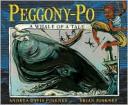by Wendy Bell
illustrated by Brian Pinkney
- Publisher and date: Jump at the Sun/Hyperion Books for Children, 2006
- Age/Grade Level: grades kindergarten – 4
- Genre: Tall Tale
Instructional Elements
Author Information and Perspective: See previous.
Notes: There’s a good whaling type of song that goes with this and could be set to music. However, even though this is a tall-tale there are images which might disturb young children, particularly those who love whales or are concerned about endangered species; i.e., the whale being turned into blubber. However, this would be a helpful book in a candid study of the whaling industry.
The author notes that whaling was one of the few industries that fostered equality between the races with all working equal jobs side by side.
Resources/Activity:
http://www.woub.org/readwritetell/story34.htm – This site offers a lesson plan about the elements of tall-tales and extends to a lesson where the students create their own.
Specific Applications in Reading Instruction: This book would be appropriate with a teacher “read-a-loud” with group discussion and study at approx. the 3rd and 4th grade levels.
Curriculum Connections: This book could be used in the general music classroom as part of a unit on African American cultural history; as part of a unit on American Sea Shanties and Sea-faring music; as part of a unit on music composition; as part of a study of music based on Tall Tales.
Literary Elements
Setting: The ocean in 1847 on a fictional whaling vessel, “The Windstead”.
Characters: Peggony-Po a wooden sailor boy, Cetus a great whale (and the antagonist), Galleon the Captain and boy’s father.
Conflict: This is very much an action story with a long, physical sea battle between Peggony-Po and the Cetus the whale. The boy is after the whale because he is on a whaling ship, but also because the whale took his father’s leg.
Themes: “Man”(boy) vs. nature; loyalty; problem solving; determination; life on the sea.
Plot: See in review
Reviews
From School Library Journal
Starred Review. Kindergarten-Grade 4–Told with humor and verve, this rollicking tall tale is about a wooden boy named Peggony-Po who promises to catch the monster whale that bit off his daddy’s leg: after all, he caught his first whale when he was only four years old. When he goes off to capture Cetus, he eschews having a boat: a masterful illustration shows him riding a wave as he chases the whale, who ingeniously exudes attitude. Cetus rams through a school of fish, so Peggony-Po did underwater cartwheels to keep those fish from crying. He never slowed down. As Peggony-Po rides Cetus from tropical waters to icy coasts, he crows, What a way to see the world! Richly descriptive similes–as feisty as a kettle of just-caught fish and Like a pressing iron flattening a shirtsleeve–and phrases such as He [Cetus] loved to smash boats with a single slam of his tail convey dynamically both the absurdity and thrilling adventure of this story, and the illustrations brim with activity and energy. Peggony-Po dances a jig from the lookout mast, he becomes alive and starts talking to his father as he is sculpted, and Cetus blows boats into the sky and rails off a fence. Every library will want to buy at least one copy of this exuberant story that begins with a whale, ends with a whale, and has a whole lot of whale in its middle.–Kirsten Cutler, Sonoma Library, CA
Copyright © Reed Business Information, a division of Reed Elsevier Inc. All rights reserved.
From Booklist
K-Gr. 2. In this original tall tale, Galleon, an African American sailor with a peg leg, takes a piece of driftwood and carves the figure of a boy, which comes to life. Galleon calls him Peggony-Po and takes him as a son. After learning that Cetus the whale ate Galleon’s leg, Peggony-Po leaps into the sea to pursue the enormous creature. Their battle of strength, wits, and determination goes on for days before Peggony-Po finally defeats the whale. The boy is a feisty, likable hero, and apart from the hard-to-sing sea chantey (no tune is provided), his fast-paced story makes a good read-aloud. Full of action and almost musical, thanks to swirling lines and repeated forms, the artwork conveys a sense of both the whale’s menacing size and the boy’s indomitable spirit. The final page offers a short introduction to black whalers in American history, a brief glossary, and one further-reading recommendation, which is more suitable for older readers. Carolyn Phelan
Copyright © American Library Association. All rights reserved.
